 |
 |
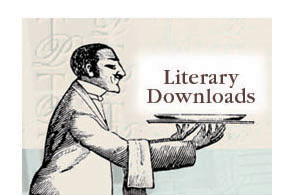
|
• About The Lark Ascending
• L’Allegro and Il Penseroso by John Milton
• Lycidas by John Milton
• Samson Agonistes by John Milton
• On the Morning of Christ's Nativity by John Milton
• The Great Debate in Hell (readings from John Milton's Paradise Lost)
• Childe Harold's Pilgrimage by Lord Byron
• "Portrait of a Lady" by T.S. Elliot
• Shakespeare's Sisters (Women of the English Renaissance)
• " When Lilacs Last in the Dooryard Bloomed" by Walt Whitman
• “Lines Written a Few Miles Above Tentern Abbey” by William Wordsworth
• Poems to Music (commissioned by The Lark Ascending)
- So, We'll No More a Roving by Lord Byron
- "the Cambridge ladies who live in furnished souls" by E.E. Cummings
- Sonnet XIII by John Milton
- Lady's Song from Comus by John Milton
- Spirit's Song from Comus by John Milton
- "Ancient Music" by Ezra Pound
- To Jane by Percy Bysshe Shelley
- The Burning Babe by Robert Sothwell
- "It Is Not a Range of a Mountain" by Gertrude Stein
- Pour Lui by Mary Stuart
|
|
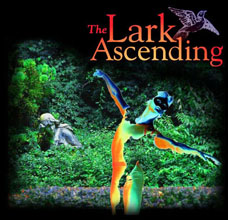
|
About The Lark Ascending
In 1997, Nancy Bogen, together with her husband Arnold Greissle-Schönberg and her long-time colleague at the College of Staten Island-CUNY Victor Mattfeld, founded The Lark Ascending, a performance group located in New York City. Its credo read as follows:
We are a group of concerned individuals in the academic and performance worlds who fear that our long and venerable Western cultural tradition is going into a kind of eclipse.
It seems to us as if books of substance are being read less and less in entirety nowadays. Equally distressing, we have heard that in many of our public schools the classics are being set aside for what is popular and easier to read, and that even literature programs in our colleges are being diluted.
In music stores, we have noted with dismay the growing number of customers in the pop music sections and the dwindling few in the classical. And we have witnessed with sadness our favorite music stations on the radio disappearing one by one until now there are but a precious few left.
With The Lark Ascending we want to sally forth with a challenge to this depressing trend and reach out with an ungloved hand to those who yearn for excellence and a camaraderie with kindred spirits. In a chamber setting, as budget allows, we will take communal pleasure in what Matthew Arnold called "the best that was thought and said in the past." We are interpreting "thought and said in the past" in the broadest sense — as being inclusive of music and art as well as literature, and of such contemporary writers, composers, and artists who derive from or claim a kinship to that past, especially composers, who all too often cannot speak for themselves. Perhaps all of us who care about these treasures of our literary and artistic legacy have a disturbing internal sense that we also may finally not be able to speak for ourselves. Alas, is it now possible that John Milton, William Blake, and Dame Edith Sitwell may go the perilous way of rain forests, whooping cranes, and baby seals? There is a tragic pattern here, and the answer may be yes.
Let us hope not....
The Lark Ascending gave its last program on April 17, 2008. Among its offerings in those eleven years were dramatic readings of literary works that at times attain an extraordinary level of performance and are surely unique. All of the materials of The Lark Ascending, including DATs and CDs, visuals, program notes, and correspondence, are due to be archived in the Library of the University of North Texas. However, both Nancy Bogen and Arnold Greissle-Schönberg felt that those wonderful readings should be made available to a wider audience. And so, after considerable reflection, it was decided to offer them gratis as downloads to anyone who cares to have them.
|
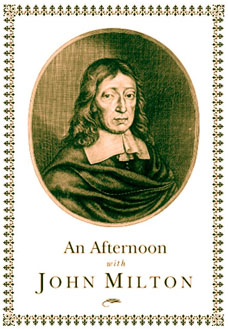
AUDIO PREVIEW:
Introduction to L’Allegro
and Il Penseroso
John Milton's L'Allegro
John Milton's Il Penseroso
READERS:
Richard Edelman
Nancy Bogen
AUDIO ENGINEER:
Merlyn Chapman-Webb
|
L’Allegro and Il Penseroso by John Milton
These two companion works were among those featured on The Lark Ascending’s first program on March 1, 1998, and were repeated on October 25, 1998, which is the version that we are offering. Here are the notes to them by Nancy Bogen that appeared in the handout program:
Literally "The Happy One" and "The Thoughtful One," these companion poems are thought to date from Milton's last summer at Cambridge, when he was 23 years old. As the titles are suggestive of music, the poems can be considered akin to two parallel movements in a musical work that offer point-for-point contrasts.
The richness of both of these poems in that respect can only emerge with successive readings. Suffice it to say here that L'Allegro’s idealized day in the country with all of its natural sights and sounds and humble rural concerns, and nights at the balls and in the theaters of "Tow'red Cities" are balanced against Il Penseroso’s meditative walking in the woods followed by a browsing among his beloved books in a "high lonely Tow'r," and a sojourn by day in the "studious Cloister's pale" and the "peaceful hermitage."
Based on Milton's devotion to formal study at Cambridge and his subsequent long course of personal study at home, it seems generally agreed that his preference would have been for the life of Il Penseroso. Nevertheless, willy-nilly both poems also clearly reflect the interests and concerns of a young man in his early twenties with a penchant for females.
Certainly telling is his preoccupation with consorting with women and the act of procreation in L'Allegro. For example, according to one genealogy, Euphrosyne or Mirth, who is described as "fair and free," was one of three daughters of Venus and Bacchus (love and wine); according to another, she was the "buxom, blithe, and debonair" daughter with whom frolicsome Zephyr (wind) "fill'd" Aurora (dawn) while "playing" with her, "As he met her once a-Maying,/ There on Beds of Violet blue,/ And fresh-blown Roses washt in dew."
In sharp contrast to this light eroticism is the foreboding origin of Melancholy given at the ...
Click here for full program notes
To download the MP3 audio file, right-click the link below, choose <Save target as> from the menu, indicate a location for your file and click Save. (Option-click Mac):
Introduction (1MB) L'Allegro (2.9MB) Il Penseroso (3.5MB)
|
|
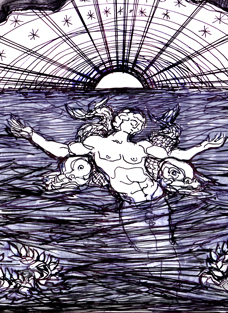
Edward King by Salvatore Tagliarino
AUDIO PREVIEW:
Introduction to Lycidas
John Milton's Lycidas
READER:
Nancy Bogen
AUDIO ENGINEER:
Merlyn Chapman-Webb
|
Lycidas by John Milton
Here are the notes by Nancy Bogen that appeared in the handout program:
Lycidas was written in November, 1637, and first appeared in 1638 in a student collection of verses commemorative of Edward King of Christ's College, Cambridge — "a fair poet, a good scholar, and a promising young clergyman" — who died in an unforeseen accident at sea in August of that year. The volume contained twenty-three poems in Latin and Greek and thirteen in English; Lycidas was the last of these.
The fourth son of Sir John King, Privy Councilor for Ireland and Secretary to the Irish Government, Edward King was admitted to Christ's College, Cambridge in 1626, one year after Milton. As the number of students at the college was small and both King and Milton were assigned William Chappell as their tutor, the two doubtless met. However, Milton was 17 to King's 14, so the possibility of a close friendship developing between them, at least initially, was highly unlikely. Further, while King seems to have been universally admired for his learning and Milton must surely have shared in that admiration, there is no evidence to suggest that they ever came to know one another well — as well as Milton and Diodati.
Why then would Milton, who had left Cambridge five years before King's untimely death, have been invited to contribute to a college memorial collection? Very likely, his reputation as a poet had lingered over those years — how would it not have after "The Nativity Ode" and "L'Allegro" and "Il Penseroso." And then it is possible that news of his recent successes with Arcades and Comus had reached there, ...
click here for full program notes
To download the MP3 audio file, right-click the link below, choose <Save target as> from the menu, indicate a location for your file and click Save. (Option-click Mac):
Introduction (1.9MB) Lycidas (6.4MB)
|
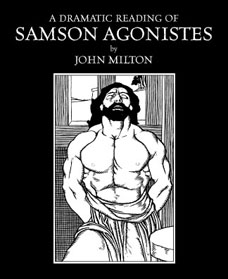
AUDIO PREVIEW:
John Milton's Samson Agonistes (pt.1)
John Milton's Samson Agonistes (pt.2)
READERS:
Samson, Richard Edelman
Chorus, Maurice Edwards
Manoa, Alfred Hyslop
Dalila, Carlotta Sherwood
Harapha, Peter Ludwig
Public Officer, Edgar Oliver
Messenger, George McGrath
MUSIC:
Four Miniatures for Viola and Guitar
by Richard Brooks
Prelude, Interlude and Finale
composed and performed by
Dinu Ghezzo
MUSICIANS:
Louise Schulman, viola
William Zito, guitar |
Samson Agonistes by John Milton
Here are the notes by Nancy Bogen that appeared in the handout program:
The Composition and Publication of Samson Agonistes
Samson Agonistes is traditionally considered Milton's final work on both thematic and stylistic grounds, and it is customary to assign the years 1667 to 1670 to its composition. John Shawcross recently made a convincing case for some composition at various junctures before then, going back to the 1640s.
Samson’s life is given in Judges XIII–XVI. As was the case with Paradise Lost, the idea of using it as material for a tragedy occurs in a document known as The Cambridge Manuscript, which dates from after Milton's return from Italy in 1639; the topics include Samson's marriages, his pride, and his triumphs as God's champion. Milton also made mention of Samson in his treatise The Reason of Church Government (1642), and there is an allusion to Samson in his Areopagitica (1644).
Samson Agonistes was published once in Milton's lifetime, in 1671, in the same volume as Paradise Regain'd.
The Literary Background of Samson Agonistes
Milton intended Samson Agonistes as a drama in the manner of Ancient Greek tragedy according to the principles expounded by Aristotle in the Poetics — i.e., unities of time, place, and action — meaning that he limited the action to the final day of Samson's life, had it occur in one place with a messenger arriving to report the tragic denouement at the Philistine temple, and made use of a Chorus as a commentator on the action. Other elements great and small also contribute to the Ancient Greek flavor of this work. For instance, Samson's tragic error, and in the end that of the Philistines, is attributed to overweening pride or hybris. Milton occasionally employed Greek dramatic strategies like stychomythia (an exchange of single lines between characters) and a riddling question-and-answer dialogue, and in the manner of Sophocles in particular, he made constant use of irony.
One should therefore not look for a lot of action in Samson Agonistes but rather consider it as a series of encounters: between Samson and the Chorus of Danites, ...
click here for full program notes
To download the MP3 audio file, right-click the link below, choose <Save target as> from the menu, indicate a location for your file and click Save. (Option-click Mac):
Agonistes (pt.1 - 25.7MB) Agonistes (pt.2 - 37.1MB)
Music by Dinu Ghezzo
Prelude Interlude1 Interlude 2 Finale
|
|
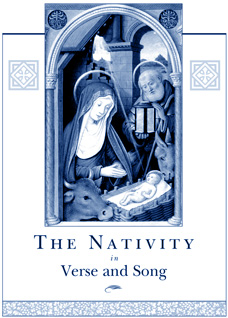
AUDIO PREVIEW:
Introduction
John Milton's
On the Morning of Christ's Nativity
READERS:
Richard Edelman
Nancy Bogen
Tom Reilly
|
On the Morning of Christ's Nativity by John Milton
Here are the notes by Nancy Bogen that appeared in the handout program:
On the Morning of Christ's Nativity dates from 1629, Milton’s Cambridge period, and is considered his first serious and lofty poetic work. It is interesting to note how Milton turned the occasion of the Nativity into a contest between the one true Judeo-Christian God and the pagan gods to show the overwhelming power of the former. Here are the elemental seeds that would reach full fruition over thirty years later in Paradise Lost.
Especially notable in On the Morning of Christ's Nativity is how sound functions as a thematic motif throughout this poem. The introduction is in the seven-line stanza of “On the Death of a Fair Infant Dying of a Cough” (1628), written in the tradition of Phineas Fletcher and, because of its final Alexandrine, ultimately of Spenser: 5a5b5a5b5b5c6c. The body of the poem employs a stanza original with Milton, but also with a clear Spenserian echo: 3a3a5b3c3c5b4e6e.
To download the MP3 audio file, right-click the link below, choose <Save target as> from the menu, indicate a location for your file and click Save. (Option-click Mac):
Introduction (256KB) On the Morning of Christ's Nativity (5.6MB)
|
|
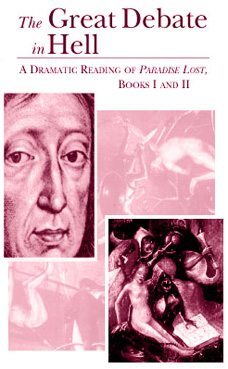
AUDIO PREVIEW:
John Milton's
Paradise Lost Books I and II (pt.1)
Paradise Lost Books I and II (pt.2)
Paradise Lost Books I and II (pt.3)
READERS:
Narrator: Russell Oberlin
Satan: Richard Edelman
Beëlzebub: Jason Bauer
Moloch: Peter Ludwig
Belial: Judith Barnes
Mammon: Isidore Elias
Chaos: Alfred Hyslop
Sin: Susan Levin
Death: Edgar Oliver
MUSIC:
Preludes to Parts I and II
by Richard Brooks
Richard Erickson, organ
Clausulae for Trombones
by Arnold Rosner
Greg Erickson, trombonist
Dale Turk, trombonist
Johannes Pfannkugh, trombonist
|
The Great Debate in Hell
(A Dramatic Reading of Books I and II of John Milton's Paradise Lost)
Here are the notes by Nancy Bogen that appeared in the handout program:
Paradise Lost is an epic on the order of Homer’s Iliad and Virgil’s Aeneid, both of which Milton used as models. Like them, it consists of twelve books; likewise, the story begins in the middle (in medias res) and doubles back on itself by means of a series of flashbacks. The characters, among whom Satan looms largest in Books I and II, are imbued with a nobility of stature but are at the same time flawed. In the course of the action, Milton employed various descriptive devices derived from Homer and Virgil, such as the long, elaborate point-for-point comparison known as the epic simile. (See, for instance, the comparison of Satan to Leviathan in I, 202-208.)
The action of Paradise Lost takes readers from the rebellion and defeat of certain angels in Heaven, headed by Lucifer, through their fall into Hell, the Creation, the subversion of Adam and Eve by Satan (hitherto Lucifer), and their expulsion from the Garden of Eden. Included in their parting instructions is a forecast of mankind’s eventual redemption through the coming and sacrifice of Jesus. Books I and II, in which the fallen angels, headed by Satan, deliberate about their next evil steps, are considered among the greatest artistic achievements of all time.
In Paradise Lost, Milton wrote in verse paragraphs, and the verse form that he employed is blank verse, which is unrhymed iambic pentameter. The term iambic refers to the prevailing rhythm in a poem. An iamb consists of two syllables, one short followed by one long; the words “because” and “along” are iambs. The term pentameter refers to the number of rhythmic units or feet on a line; penta means “five,” so a pentameter line would normally consist of five units or feet. An ideal iambic pentameter line would consist of five iambs, as in the following line from John Keats’s sonnet: “When I have fears that I may cease to be.”
Milton’s blank verse in Paradise Lost and that of Shakespeare, who came before him, are quite different. Shakespeare wrote for the stage, and his lines tend to be end-stopped and rather irregular, especially as to length; his signature-line consisted of ...
click here for full program notes
To download the MP3 audio file, right-click the link below, choose <Save target as> from the menu, indicate a location for your file and click Save. (Option-click Mac):
Paradise Lost (pt.1 - 19MB) Paradise Lost (pt.2 - 17.3MB) Paradise Lost (pt.3 - 14.6MB)
Music Preludes by Richard Brooks:
Prelude to Part I Prelude to Part II
Music Preludes by Arnold Rosner, Clausulae for Trombones:
Prelude 1 Prelude 2 Prelude 3
|
|
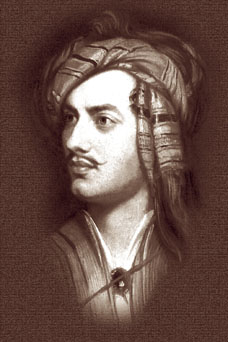
AUDIO PREVIEW:
Introduction
Lord Byron's Canto IV of
Childe Harold's Pilgrimage
READERS:
Russell Oberlin
Richard Edelman
MUSICIAN:
Dennis Cenelli, guitar
|
Canto IV of Childe Harold’s Pilgrimage by Lord George Gordon Byron
Here are the notes by Nancy Bogen that appeared in the handout program:
Begun in late June 1817 in Venice, this last canto of Byron’s monumental work was finished on January 8, 1818; Byron’s lifelong friend and traveling companion John Cam Hobhouse, to whom it was dedicated, carried it back to England, where it was published by John Murray.
Leslie Marchand, in Byron’s Poetry, provides the best summary and description of its scope:
The fourth canto of Childe Harold interweaves the pageant of Byron’s bleeding heart with the pageant of Italy from Venice to Rome and achieves the finest statement of the sic transit theme, retracing Roman history in that “marble wilderness’ of that ‘city of the soul’.” The autobiographical part has less of the hectic urgency to relieve the pain of “love inextinguishable” and “thoughts unutterable” (though some of the desolation is still there ) than in the third canto....
The fourth canto, unlike the first and third, does not begin with an agonized statement of his own quandary. It is intensely subjective, but it is a personal view of Venice and her beauty in decay....
The best solace is to “meditate amongst decay.” After a tribute to Italy, “the Garden of the World, the Home\Of all Art yields,” he began the pilgrimage.
The scope of the pilgrimage is indeed encyclopedic both chronologically and geographically. Among the highlights are Arqua and Petrarch; Ferrara and Tasso; Florence, Ariosto, and Dante; and then the Rome of Tully, Virgil, and Livy; of the Coliseum, the Dying Gladiator, the Pantheon, the Castle of St Angelo, St Peter’s, the Laocoon, and Apollo Belvedere.
To download the MP3 audio file, right-click the link below, choose <Save target as> from the menu, indicate a location for your file and click Save. (Option-click Mac):
Introduction (1MB) Childe Harold's Pilgrimage (19MB)
|
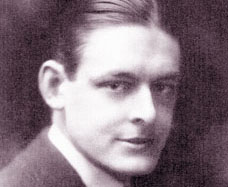
AUDIO PREVIEW:
T.S. Elliot's "Portrait of a Lady"
READERS:
Richard Edelman
Nancy Bogen
|
“Portrait of a Lady” by T.S. Elliot
Here are the notes by Nancy Bogen that appeared in the handout program:
Written in 1909-1910 while T.S. Elliot was still at Harvard, this poem is a descriptive monologue that came as a result of a friendship with a lady — an older woman — in Cambridge. Less popular than “Prufrock,” it is nevertheless an interesting and important document in the development of T.S. Eliot’s style.
Featured is a younger, more immature version of the male voice — adolescent, one might say. The women of “Prufrock” in single and multiple voices are here combined into one, a spinster for whom the young man is a last chance at love.
To download the MP3 audio file, right-click the link below, choose <Save target as> from the menu, indicate a location for your file and click Save. (Option-click Mac):
"Portrait of a Lady" (3MB)
|
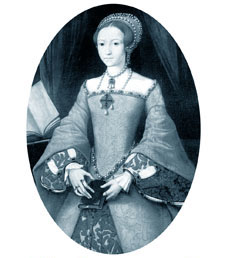
AUDIO PREVIEW:
Introduction
READERS:
Elizabeth Farnum
Mary Hurlbut
Ronn MacFarlane
Carlotta Sherwood
Virginia Wolfe |
Shakespeare's Sisters
Women of the English Renaissance in Verse and Song
Here are the notes by Nancy Bogen that appeared in the handout program:
In 1929, puzzling in her Room of One’s Own “why no woman [in Shakespeare’s England] wrote a word of that extraordinary literature when every other man, it seemed, was capable of song or sonnet,” Virginia Woolf tried to conjure up the plight of Judith Shakespeare, the gifted, imaginary sister of the poet. Aware that Renaissance morés, based on century-old conceptions of woman’s nature and condition, constrained women to chastity, humility, obedience, and silence, Woolf concluded that “any woman born with a great gift in the sixteenth century would certainly have gone craz’d, shot herself, or ended her days in some lonely cottage, half witch, half wizard, feared and mocked at. . . . [W]hatever she had written would have been twisted and deformed, issuing from a strained and morbid imagination.”
Over the last twenty years, scholars have confirmed many of the details of the sometimes pitiable life circumstances of Shakespeare’s sisters — disabled under law, more limited in educational and economic options than men, exhorted to humility and submissiveness and to an acceptance of their lot by their spiritual leaders. Simultaneously and surprisingly, this confirmation has been accompanied by a recovery of close to 100 separately printed writings ....
click here for full program notes
To download the MP3 audio file, right-click the link below, choose <Save target as> from the menu, indicate a location for your file and click Save. (Option-click Mac):
Introduction (424KB)
|
AUDIO PREVIEW:
Introduction
Anne Askew Kyme
READER:
Carlotta Sherwood |
ANNE ASKEW [KYME] (1521–1546)
Some years after she was forced by her father to marry Thomas Kyme, the fiancé of her deceased sister, and had borne him two children, Anne Askew, who had become a Protestant, was driven out of their home by her husband. After several adventures, she made her way to London where she became connected to a group of reformist women surrounding Katherine Parr, the sixth wife of Henry VIII. Her initial examination over her beliefs by London authorities, in 1545, may have been instigated by her husband and his family. Her second examination, torture, and execution, in 1546, were likely the result of efforts by conservatives at court to undermine the reformist queen. After the uncowed Askew was burned at the stake (on July 16, 1546), John Bale caused her two “Examinations,” smuggled out of the prison, to be printed abroad with the interpolation of his extensive commentary. The whole was reprinted in John Foxe’s Actes and Monumentes (1564), with a striking woodcut of Askew’s execution. Askew’s moving “Balade whych Anne Askewe made and sange whan she was in Newgate,” which was printed at the conclusion of her “Lattre Examinacyon,” voices her determination “to feare no worldes dystresse,” and her wishes for mercy for the enemies who had tortured her.
To download the MP3 audio file, right-click the link below, choose <Save target as> from the menu, indicate a location for your file and click Save. (Option-click Mac):
Introduction (828KB) Anne Askew Kyme (4.6MB)
|
|
AUDIO PREVIEW:
Introduction
Amelia Bassano Lanyer
READER:
Virginia Wolfe |
AEMILIA (BASSANO) LANYER (1569–1645)
The daughter of a court musician, Aemilia Lanyer, who has been hypothesized to have been the “Dark Lady” celebrated in Shakespeare’s sonnets, was married in 1592 to another court musician. Her “Description of Cookeham” was printed together with her longer “Salve Deus Rex Judaeorum” in 1611, two years before her husband’s death. “Salve,” a graceful description of the fall and Christ’s passion, is punctuated by defences of women, with the fall itself reinterpreted in Eve’s favor. “Cookeham,” a description of the idyllic community formed by Lanyer and two female patronnesses, Margaret Russell, Countess of Cumberland, and her daughter Anne Russell Clifford, that was disrupted by Anne’s impending marriage, claims pride of place as the first country-house poem in the language. While differences in rank are a consideration in the poem, “Cookeham” differs from Jonson’s “To Penshurst,” which had been accorded that place until recently, in focusing on the community of the women rather than on the symbols of patriarchal power.
To download the MP3 audio file, right-click the link below, choose <Save target as> from the menu, indicate a location for your file and click Save. (Option-click Mac):
Introduction (1MB) Amelia Bassano Lanyer (5.2MB)
|
AUDIO PREVIEW:
Introduction
Elizabeth I and Mary Stuart
READERS:
Elizabeth Farnum
Carlotta Sherwood |
ELIZABETH I (1533-1603) and MARY STUART (1542–1587)
Elizabeth Tudor’s sex so disappointed her father, Henry VIII, that it led to his shedding her mother, Anne Boleyn, his second wife, as part of his frantic effort to beget a male heir to the English throne. Ironically, despite being decreed a bastard by her father, Elizabeth did eventually succeed him, outliving her stepsisters and Henry’s sons and proving a remarkably resilient and long-lived ruler who lent her name to Shakespeare’s age. It seems probable that her refusal to marry was founded on her sage appreciation of the hazards and disabilities of married life even for sixteenth-century queens ....
click here for full program notes
To download the MP3 audio file, right-click the link below, choose <Save target as> from the menu, indicate a location for your file and click Save. (Option-click Mac):
Introduction (756KB) Elizabeth I and May Sturart (1.8MB)
|
AUDIO PREVIEW:
Introduction
Mary Sidney Herbert
READERS:
Richard Edelman
Carlotta Sherwood
|
MARY (SIDNEY) HERBERT (1561–1621)
Born to a very important noble family, “Sidney’s sister” was married very young to the powerful and much older earl of Pembroke. During her long, privileged life, she played an important role in the evolution of English literature, providing patronage to many of the literary lights of her time; editing her brother Philip’s Arcadia; writing some original poems; translating a closet drama, Petrarch’s Trionfi, and a number of Protestant tracts; and completing a translation of the Psalms begun in collaboration with her brother. Although this translation remained in manuscript until the nineteenth century, it circulated widely in her time.
“The Doleful Lay of Clorinda,” a mourning ode for her brother, first appeared in Edmund Spenser’s Colin Clouts Come Home Again (1595). Although external evidence and the physical presentation of the poem support the attribution to Herbert, an attribution that was not contested until the early twentieth century, some critics, ignoring the contextual evidence and even Spenser’s own statement, argue that the poem is actually Spenser’s.
To download the MP3 audio file, right-click the link below, choose <Save target as> from the menu, indicate a location for your file and click Save. (Option-click Mac):
Introduction (1.7MB) Mary Sidney Herbert (1.7MB)
|
AUDIO PREVIEW:
Introduction
Isabella Whitney
READER:
Elizabeth Farnum |
ISABELLA WHITNEY (fl. 1566–1573)
Assumed to be the sister of Geoffrey Whitney (1548?-1601?), author of a minor emblem book, Isabella Whitney seems to have been a presence in the literary world of mid-sixteeenth-century London — a Judith Shakespeare. She is author of two miscellanies of verse, Copy of a Letter (1566) and A Sweet Nosgay (1573), and may have written a few scattered poems, as well. Her earlier volume consists of a number of high-spirited love complaints, some in a female voice. Lines in her second volume, a series of poems that tells of her ill fortune, suggest that she was of gentle, though not exalted, birth; that she was from a large family; that two of her younger sisters, to whom she offers advice, were in service; that she had herself been in service but had lost her position; that she is ill and financially hard-pressed.
Her ill health and ill fortune, offset a bit by the support of family and friends to whom she addresses poetic epistles, lead her to compose the most substantive poem in the volume, her “Wyll and Testament” to London before she is forced to leave the city. This mock testament, with which she ends the book, ranges over the city’s neighborhoods and brings its streets and populace to life. A highly original poem, Whitney’s “Wyll and Testament” has affinities with the character sketches of the earlier “Cock Lorell’s Boat” as well as with the later cony-catching pamphlets and city comedies.
To download the MP3 audio file, right-click the link below, choose <Save target as> from the menu, indicate a location for your file and click Save. (Option-click Mac):
Introduction (524KB) Isabella Whitney (5.6MB)
|
AUDIO PREVIEW:
Introduction
Mary Sidney Wroth
READER:
Elizabeth Farnum
Carlotta Sherwood
Virginia Wolfe |
MARY (SIDNEY) WROTH (1587–1653?)
Mary Sidney Wroth, another member of the Sidney family circle of poets and, in her younger years, a member of the court circle surrounding James I, was the first woman to write an original work of prose fiction in English. Sale of her Countesse of Montgomeries Urania (1621), in some ways a feminized Arcadia, was halted under a barrage of criticism by courtiers who believed they had been attacked in the work. In addition to poetry interpolated into the romance, Urania culminates in a separately paged collection of poems. Among them is the skillful “Crowne of Sonnets dedicated to Love,” a corona of fourteen sonnets in a female voice. The last line of each sonnet in the corona is repeated as the first line of the next, with the last line of the fourteenth completing the cycle by repeating the first line of the first sonnet. Robert Sidney, the father of the poet, also composed a corona of love sonnets, although his corona was not completed.
To download the MP3 audio file, right-click the link below, choose <Save target as> from the menu, indicate a location for your file and click Save. (Option-click Mac):
Introduction (348KB) Mary Sidney Wroth (1.7MB)
|
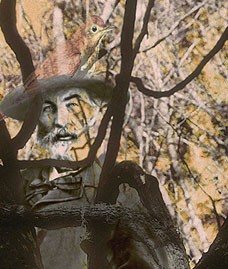
AUDIO PREVIEW:
Introduction
Walt Whitman's
When Lilacs Last in the Dooryard Bloomed
NARRATORS:
Russell Oberlin
Elizabeth Farnum
MUSIC:
"Song of the Hermit Thrush"
by Martin Halpern
MUSICIANS:
Elizabeth Farnum, soprano
Elizabeth Rodgers, piano |
“When Lilacs Last in the Dooryard Bloomed” by Walt Whitman
Here are the notes by Nancy Bogen that appeared in the handout program:
Walt Whitman's admiration of Abraham Lincoln bordered on infatuation. He saw in Lincoln's efforts to preserve the Union the most important meaning of the Civil War. In his journal, Specimen Days, he wrote of their encounters in the streets of Washington, D.C., during the early 1860s:
I see the President almost every day, as I happen to live where he passes to and from his lodgings . . . . Mr. Lincoln on the saddle generally rides a good-sized easy-going gray horse, is dress'd in plain black, somewhat rusty and dusty, wears a black stiff hat, and looks about as ordinary in attire, &c., as the commonest man. . . .I see very plainly Abraham Lincoln's dark brown face, with the deep-cut lines, the eyes, always to me, with a deep latent sadness in the expression. We have got so we exchange bows, and very cordial ones.
Describing the president's careworn face at his second inauguration, Whitman wrote of “all the old goodness, tenderness, sadness, and canny shrewdness, underneath the furrows. (I never see that man without feeling that he is one to become personally attach'd to, for his combination of purest, heartiest, tenderness, and native western form of manliness.”)
The assassination of his idol was greeted with great silence and depression in the Whitman household, and of course Whitman had to turn his poetic genius to commemorating this man who had meant so much to him. His first effort, written not long after Lincoln's death, was "O Captain, My Captain." In it he set aside his creative free verse for a return to traditional rhyme and meter and fashioned a sentimental and maudlin portrait of Lincoln as the fallen captain ....
click here for full program notes
To download the MP3 audio file, right-click the link below, choose <Save target as> from the menu, indicate a location for your file and click Save. (Option-click Mac):
Introduction (1.2MB) When Lilacs Last in the Dooryard Bloomed (10.1MB)
|
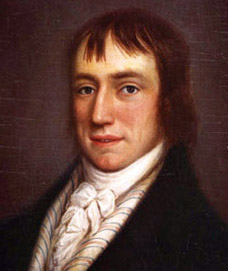
AUDIO PREVIEW:
Introduction
William Wordsworth's
"Lines Written a Few Miles Above
Tentern Abbey"
READER:
Maurice Edwards |
“Lines Written a Few Miles Above Tentern Abbey” by William Wordsworth
Here are the notes by Nancy Bogen that appeared in the handout program:
Written in 1798, this poem was one of the highlights of The Lyrical Ballads (1798). Wordsworth’s note on the poem’s composition is worth considering:
No poem of mine was composed under circumstances more pleasant for me to remember than this. I began it upon leaving Tintern, after crossing the Wye, and concluded it just as I was entering Bristol in the evening, after a ramble of four or five days, with my Sister. Not a line of it was altered, and not any part of it written down till I reached Bristol.
While it is never subtitled or referred to as an ode, Wordsworth made it clear in a note to the 1800 edition of The Lyrical Ballads that he thought of it in terms of one: "I have not ventured to call this Poem an Ode; but it was written with a hope that in the transitions, and the impassioned music of the versification, would be found the principal requisites of that species of composition." According to the classification of Thrall, Hubbard, and Holman in A Handbook to Literature, this poem ....
click here for full program notes
To download the MP3 audio file, right-click the link below, choose <Save target as> from the menu, indicate a location for your file and click Save. (Option-click Mac):
Introduction (12.7MB) "Lines Written a Few Miles Above Tentern Abbey" (146.6MB)
|
|
Poems to Music
From the outset, one of our intentions at The Lark Ascending was to commission some of our composers to set literary poems to music and to present those works as part of a regular program. The rules were simple: the work had to be no shorter than 8 and no longer than 10 minutes in duration, and the composer was to score it for the same musical forces that were being used on the rest of the program. In this way, we hoped to lead our audiences from the familiar to the new and rare and unfamiliar—for instance, from Byron’s “So We’ll Go No More A-Roving”—to a setting by American composer Charles Griffin. Each of those lieder are quite wonderful, exceeding our wildest dreams. Please help yourself and feel free to pass the word along, remembering that our serious composers, to say nothing of our whole civilization nowadays, are an endangered species.
So, We'll No More a Roving
Poem by Lord Byron Musical setting by Charles Griffin
MUSICIANS:
Elizabeth Farnum, soprano
Peter Vinograde, piano
"the Cambridge ladies who live in furnished souls"
Poem by E.E. Cummings Musical setting by Elodie Lauten
MUSICIANS:
Mark Duer, baritone
Chris Finckel, cello
Katherine Fink, flute
Steven Hartman, clarinet
Albert Regni, saxophone
Sonnet XIII
Poem by John Milton Musical setting by Arnold Rosner
MUSICIANS:
Mary Ann Hart, mezzo soprano
Gwendolyn Toth, harpsichord
Lady's Song from Comus
Poem by John Milton Musical setting by Arnold Rosner
MUSICIANS:
Mary Ann Hart, mezzo soprano
Gwendolyn Toth, harpsichord
Spirit's Song from Comus
Poem by John Milton Musical setting by Arnold Rosner
MUSICIANS:
Mary Ann Hart, mezzo soprano
Gwendolyn Toth, harpsichord
"Ancient Music"
Poem by Ezra Pound Musical setting by Elodie Lauten
MUSICIANS:
Mark Duer, baritone
Chris Finckel, cello
Katherine Fink, flute
Steven Hartman, clarinet
Albert Regni, saxophone
To Jane
Poem by Percy Bysshe Shelley Musical setting by Arnold Rosner
MUSICIANS:
Elizabeth Farnum, soprano
Peter Vinograde, piano
The Burning Babe
Poem by Robert Southwell Musical setting by Stephen Douglas Burton
MUSICIANS:
The Four Nations Ensemble
Andrew Appel, director and harpsichord
Ryan Brown, violin
Loretta O'Sullivan, cello
with
Jonathan Sternberg, narrator
Amanda Balestrieri, soprano
Nils Brown, tenor
Geoffrey Burgess, oboe d'amore
Nina Falk, viola
Claire Jolivet, violin
Rosamund Morley, violone
David Newman, baritone
Owen Watkins, recorder
Matthew White, alto
"It Is Not a Range of a Mountain"
Poem by Gertrude Stein Musical setting by Elodie Lauten
MUSICIANS:
Mark Duer, baritone
Chris Finckel, cello
Katherine Fink, flute
Steven Hartman, clarinet
Albert Regni, saxophone
Pour Lui
Sonnets in French by Mary Stuart Musical setting by Memrie Innerarity
MUSICIANS:
Shirley Perkins, soprano
Ronn McFarlane, lute
|
|
|
| |
|